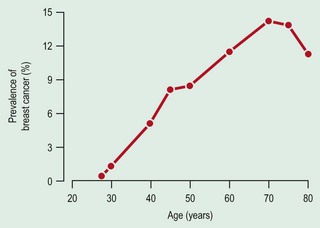10 Breast disease
Benign breast disease
Breast lumpiness and lumps
It is vital, but sometimes difficult, to distinguish whether a breast lump is part of a diffuse lumpiness or a discrete, isolated lump. The diagnosis may be influenced by whether the lump is painful and/or the age of the patient (Table 10.1).
Table 10.1 Likely diagnosis of discrete breast lumps at different ages
| Young adult | Fibroadenoma |
| Middle-aged | Cyst |
| Elderly | Carcinoma |
Breast cancer
Epidemiology and aetiology
The risk factors for breast cancer are listed in Table 10.2.
| Factor | High risk | Low risk |
|---|---|---|
| Age (years) | Greater than 50 | Less than 35 |
| Country of birth | Northern Europe, North America | Asia or Africa |
| First-degree relative affected | Yes | |
| Age at first pregnancy | >30 years | <20 years |
| Nulliparity | Yes | |
| Previous breast cancer | Yes | |
| History of atypical hyperplasia | Yes |








